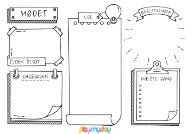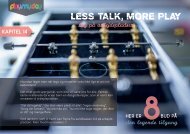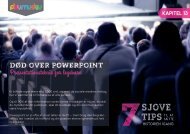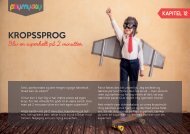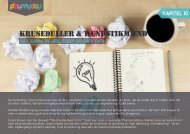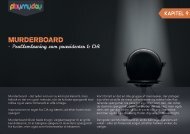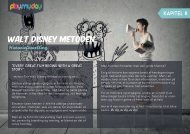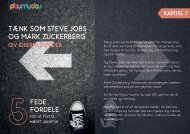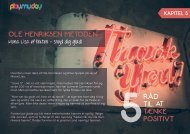PlayMyDay_report2
Play My Day report - a litterature review of the benefits of play in the workplace and qualitative pi,ot study of Playbox by Koncept Kompagniet
Play My Day report - a litterature review of the benefits of play in the workplace and qualitative pi,ot study of Playbox by Koncept Kompagniet
You also want an ePaper? Increase the reach of your titles
YUMPU automatically turns print PDFs into web optimized ePapers that Google loves.
!1<br />
Play my Day: a literature review of the benefitsof play in the workplace and<br />
qualitative pilot study of PlayBox by Koncept Kompagniet<br />
Author of report:<br />
Samuel West, PhD.<br />
Organizational Psychology<br />
Lund University, Sweden<br />
The Playbox, organizational play and workplace meetings<br />
Koncept Kompagniet’s PlayBox is a toolkit of carefully selected toys and games that are used to<br />
encourage playfulness during workplace meetings. The included Play Guide suggests how the toys<br />
can be used to add a playful dimension to various common meeting objectives such as enhancing<br />
creativity, communication and decision making.<br />
The main aim of this report is to explore the scientific evidence for the benefits of inducing play in<br />
workplace. This report presents an overview of the research on the benefits of organizational play<br />
and provides evidence that playing at work is a promising means by which to improve workplace<br />
meetings. Play has been linked to improved creativity, communication, engagement, learning,<br />
performance, and enhancing relationships. As the Playbox is developed as a tool for improving<br />
workplace meetings this report will attempt to highlight play in the context of organizational<br />
meetings. But first, lets start with some historical context:<br />
When we are at work we ought to be at work. When we are at play we ought to be at play. There is<br />
no use trying to mix the two. The sole object ought to be to get the work done and to get paid for it.<br />
When the work is done, then the play can come, but not before. - Henry Ford<br />
Play was unwelcome in Henry Ford's factories. His employees were there to work, not to play and it<br />
is clear that there should be no mixing of the two. This anti-play approach to work has outlived the<br />
industrial revolution and the notion that work and play are opposites still lingers in many<br />
workplaces. As we move away from the factories of the industrial revolution and find ourselves in<br />
the knowledge-based economy, play seems to be increasingly welcomed in the workplace, and there<br />
is growing evidence of the benefits of play in the workplace.<br />
A recent conceptualization defines play as an absorbing and intrinsically motivated activity that is<br />
apparently purposeless and provides enjoyment and a suspension of self-consciousness (Brown,<br />
2009). Play is defined as a »a state of mind« and as a behavioral approach to an activity. To be<br />
playful at work involves approaching a work task in such a way that it is more enjoyable for oneself<br />
and others. The five characterizing elements of play are that it be self-chosen, fun, frivolous,<br />
imaginative, and in some way bound by structure or rules (West, 2013).<br />
Team meetings are ever-present in modern organizations (Allen, Lehmann-Willenbrock, &<br />
Rogelberg, 2015). The average employee spends more than six hours per week in scheduled<br />
meetings. Supervisors spend twice as much time in formal meetings, and in larger organizations<br />
managers spend more than 75% of their time preparing and executing meetings. Many managers<br />
spend up to 80% of their working time in meetings. The average employee has at least 3 meetings
!2<br />
per week, but meeting quality is evaluated as poor in 41.9% of these meetings (Allen et al, 2015).<br />
There is much room for improvement of workplace meetings!<br />
Creativity<br />
Research in organizational psychology has established play as a powerful enhancer of creativity.<br />
Playfulness has been identified as an essential aspect of a creative organizational climate and an<br />
encourager of a creative and innovative work environment. (Ekvall, 1996; Starbuck & Webster,<br />
1991; Deal & Key, 1998; Costea, Crump, & Holm, 2005; Mainemelis & Ronson, 2006; Statler,<br />
Roos, & Victor, 2009; Chang, 2011). Experimental research suggest that play triggers a shift<br />
towards a creative state of mind and directly benefits creative performance. The following are some<br />
examples of playful activities that have in peer-reviewed articles been reported to boost creativity:<br />
• Playing silly meeting games. (West, Hoff & Carlsson, 2015)<br />
• Temporarily imagining oneself as a child. (Zabelina & Robinson, 2010).<br />
• Framing work tasks as playful (Glynn, 1994)<br />
• Playing table-top role playing games. (Chung, 2012)<br />
• Playing a physically active video games (Hutton & Sundar, 2010)<br />
• Role play games (Karwowski & Soszynski, 2008)<br />
• Lego blocks in the board room (Statler, Roos, & Victor, 2009; Statler, Heracleous, & Jacobs,<br />
2011).<br />
• Improvisational theater games (West, 2015)<br />
• Tinkering with art supplies and plastic building blocks (Schulz, Geithner, Woelfel, & Krzywinski,<br />
2015; Nisula, Kallio, Oikarinen, & Kianto 2015).<br />
Research has suggested a number of theoretical mechanisms by which play increases creativity.<br />
Playing stimulates mental flexibility by expanding perspectives and practicing the use of<br />
imagination. Imagining new information, situations and relationships that are not true in the real<br />
world is possible in the imaginary world created by play. (Brown, 2009; Russ, 2011). The<br />
frivolousness of play, and the excuse to be spontaneous and silly allows individuals to temporarily<br />
let go of prestige and correctness which are obstacles to creativity. (West, 2013). Play allows us to<br />
temporarily suspend organizational objectives, encouraging experimentation and exploration. A<br />
playful climate also fosters risk-taking mistake-making (Dodgson, Gann & Salter, 2005; West,<br />
2015)<br />
Neuropsychologists have found that play develops novelty and behavioral flexibility in both<br />
animals and humans (Bateson & Martin, 2013). Arguing that play is a source of behavioral variety,<br />
researchers within organizational psychology have suggested that play promotes creativity by<br />
giving employees a legitimate excuse to behave in new ways (March, 1991).<br />
A playful work climate encourages employees to be open for the unexpected by generating a<br />
surplus of possibilities and allowing them to operate with indeterminate expectations (Roos, Victor<br />
& Statler, 2004). Play also exercises non-judgement and openness to others. In the safe boundaries<br />
of play, habitual beliefs can be questioned which facilitates a shift of perspectives (Barry &<br />
Meisiek, 2010). Research has also shown the introducing play in workplace meetings enhances the<br />
the experienced creative climate in organizational meetings (West, 2014).<br />
Although not yet well-researched, one interesting theory suggests that the element of playful<br />
surprise in workplace meetings may partially explain the how play benefits organizational creativity
!3<br />
(Filipowicz, 2006). Also on an different note, unconventional leader behavior (such as standing on<br />
furniture, hanging ideas on clotheslines) has been shown to lead to increased creativity among<br />
subordinates (Jaussi, & Dionne, 2003).<br />
Performance and productivity<br />
Workplace meetings are often experienced as being unproductive to the extent that ineffective<br />
meetings are dreaded by many employees (Allen et al., 2012). Unproductive meetings have also<br />
been associated with decreased job satisfaction and may effect employees’ well-being (Rogelberg,<br />
Allen, Shanock, Scott & Shuffler, 2010). Due to the frivolous nature of play it is understandable that<br />
it is not always welcome in organizational contexts, such as meetings, where efficiency and a focus<br />
on results are relentlessly pursued. Seen as a waste of time, play becomes a threat to organizational<br />
productivity and must therefore be managed, minimized and controlled (West, 2014). However,<br />
play scholars have suggested that play may in fact enhance productivity in the workplace by making<br />
work tasks more fun and engaging (DeKoven, 2014). Advocates of organizational play have argued<br />
that play and having fun at work leads to enhanced productivity as playful activities allow<br />
employees to develop cognitive, social, and emotional capacities that are conductive to a productive<br />
work environment (Starbuck & Webster, 1991; Statler, Roos & Victor, 2009; Owler, Morrsion, &<br />
Plester, 2010). There is good evidence that humor and a fun work environment enhances team<br />
performance (Romero & Pescosolido, 2008). Research exploring the effect of playfulness on the<br />
productivity of workplace meetings has found that adding playful elements to otherwise mundane<br />
work meetings leads to an increase of experienced productivity (West 2015).<br />
Workplaces that require their employees to persist to solve complex problems can greatly benefit<br />
from creating a playful culture that encourages the use of humor. Exposure to humor and<br />
amusement increases persistence in challenging work tasks. (Cheng & Wang, 2014). Team<br />
collaboration requires the meeting participants interact with each other (Bonito & Sanders, 2010).<br />
Playful games and activities during meetings create a forum for positive social interaction that is<br />
vital for collaborative meetings. The frequency of interaction behaviors such as problem-solving,<br />
action planning lead to improved meeting satisfaction, productivity, and even organizational success<br />
(Kauffeld & Lehmann-Willenbrock, 2012).<br />
Engagement and intrinsic motivation<br />
One of the core characteristics of play is that it is fun and intrinsically motivated,and play is often<br />
social and physical. It should therefore not be surprising that play has been linked to an increase of<br />
energy levels and enhanced engagement (Mainemelis & Ronson, 2006). Play engages us at work by<br />
tapping into out intrinsic motivation by being inherently enjoyable and creating scripts for people to<br />
engage in. Put another way: The fun of play increases participation and engagement. As an<br />
energizer, play activities provide both novel physical and mental challenges that stimulate body and<br />
mind (West, 2013). Laboratory experiments have found that playfully performing challenging work<br />
tasks increased intrinsic motivation (Glynn,1994). Group intrinsic motivation also increases when<br />
the meeting chairperson or leader displays playful behavior (Jaussi, & Dionne, 2003).<br />
Relationships and communication<br />
Play fosters joy and goodwill amongst team members (Roos & Roos, 2006). Research focusing on<br />
play in the work environment has suggested that play builds collaborative relationships. In the safe<br />
boundaries of play meeting participants are free to deviate from socially prescribed behaviors and<br />
ordinary conventions which allow them to relate to others in new ways (Mainemelis & Ronson,<br />
2006). Play promotes high-quality exchanges amongst team members (Muñoz-Doyague & Nieto,
!4<br />
2012), and is thought to serve as an effective shortcut to developing and maintaining the level of<br />
psychological safety needed for team work (West, 2016).<br />
The fun and silly aspects of play include a lot of humor. Research on humor in the workplace helps<br />
explain the benefits of play for building relationships in the workplace. Humor and laughter have<br />
likely evolved as group behaviors because they promote group cohesion (Gervais & Wilson, 2005;<br />
Van Vugt & Kameda, 2013). Playfulness and shared laughter reduces tension in problematic<br />
situations and enhance communication and collegiality. (Kangasharju & Nikko, 2009). Humor<br />
decreases tensions and facilitates communication (Meyer, 2000; Holmes & Marra, 2002)<br />
Researchers focusing on organizational meetings have found that playful humor triggers positive<br />
socioemotional communication (Lehmann-Willenbrock, & Allen, 2014).<br />
An interesting “side-effect” of play related to improving relationships and communication is that<br />
play seems to counteract the negative effects of organizational hierarchy. By bringing fun into<br />
relationships play helps break hierarchical and social barriers so that people find a common<br />
connection point and move into meaningful collaborative relationships (West, Hoff & Carlsson,<br />
2013).<br />
Promotes learning<br />
Organizational researchers have reported that ludic learning (playful learning) promotes deep<br />
learning (Kolb,& Kolb, 2010). A playful work or meeting environment experientially teaches team<br />
members to be aware that there is no right way to think and act (Bakken et al., 2012). Playing<br />
games has been successfully used to teach positive social interaction and interpersonal dynamics in<br />
organizations (Bogers & Sproedt, 2012). Playing with toys during workplace meetings may also<br />
foster learning by establishing a collective shared understanding. Getting a group of professionals<br />
from different backgrounds and with different stakeholder positions to collaborate is a formidable<br />
task for meeting organizers. A recent study reported that playing with art supplies and plastic<br />
building blocks enhances collaborative learning amongst diverse stakeholder groups (Schulz,<br />
Geithner, Woelfel, & Krzywinski, 2015). One means by which play aids learning in organizational<br />
groups is by increasing a sense of psychological safety which fosters knowledge sharing (Kessel,<br />
Krater, & Schultz 2012).<br />
A recent doctoral thesis studying the positive effects of playful teaching with adults in higher<br />
education highlighted the elements of high energy, fun, lightheartedness, and spontaneity as being<br />
benefitional to learning. Moreover, educators identified the unexpected, surprise or unplanned<br />
occurrence as being a vital aspect of a the playful classrooms that benefit a deeper more engaged<br />
learning (Tanis, 2012).<br />
Playing for a healthy work environment<br />
Playfulness, especially the fun and silliness of playfulness, is associated with positive psychological<br />
functioning in adults (Proyer & Ruch, 2011). Organizational leaders often use playful joking as a<br />
coping strategy, which helps them to put a problem into perspective and examine various<br />
interpretations (Grugulis, 2002). Functioning as temporary diversion from work tasks, play may<br />
function as relief from stress or boredom (Mainemelis & Ronson, 2006). A playful fun work climate<br />
may be especially important for modern organizations wishing to retain talent. Younger generations<br />
of employees expect work to be fun and creative, and providing opportunities for this is becoming a<br />
competitive advantage (Romero & Pescosolido, 2008). In addition to fostering employee wellbeing,<br />
play can also be exploited to improve leadership skills and to contribute to leadership<br />
development (Kark, 2011).
!5<br />
Qualitative interview study<br />
A pilot study was done to explore the real-life experiences of using the Playbox as well as<br />
participants’ observed benefits to workplace meetings.<br />
Participants and procedure<br />
The Playbox was evaluated by seven different organizations in Denmark and Sweden. Each client<br />
tested the Playbox for about 2-3 weeks. A representative or contact person from each participating<br />
organization was then interviewed. There were four males and three females that varied in age from<br />
33 to 52 years. The organizations represented a diverse spectrum of large and smaller businesses as<br />
well as governmental organizations. Four participants were from companies from the private sector:<br />
facility management (Sweden), conference center (Sweden), organizational development<br />
consultants (Denmark), and a software engineering firm (Sweden). Three participating<br />
organizations were from the public sector: department of culture at a city municipality (Sweden), a<br />
medical healthcare center (Sweden), and a business college (Denmark).<br />
The participating organizations were recruited as testers after expressing interest in the Playbox,<br />
being willing to test the Playbox and committing to being interviewed about their experiences. As<br />
the study aimed to explore the practical use of the Playbox in the field rather than be a basis for<br />
theory generation, the respondents were selected to represent a diverse variety of organizations and<br />
meeting environments. Participants were interviewed in person or by phone and eventual follow-up<br />
questions were answered by e-mail. The interviews lasted about 20 minutes.<br />
A semistructured interview guide was constructed to explore how the Playbox was used in various<br />
meeting contexts and how the Playbox influenced the meetings (Patton, 2001). The interview guide<br />
provided direction and structure, yet encouraged free on-topic discussion as well as any<br />
unanticipated points. Follow-up questions were actively posed to encourage the development of<br />
ideas (Kvale, 1997). The main themes of the interview guide were: general thoughts about the<br />
Playbox and initial expectations, and more importantly their experiences of using the Playbox in<br />
different workplace meetings. Participants were requested to give concrete examples and<br />
descriptions of using the Playbox.<br />
Results<br />
Initial thoughts and expectations<br />
Many participants explained that their initial enthusiasm for the Playbox was that it is new and<br />
exciting, and that they were motivated to test the box out of curiosity. A common theme was that<br />
they expected the box to liven up and energize their meetings. They furthermore hoped that the box<br />
would make their meetings a little more fun and engaging as well as lead to increased creativity. As<br />
a manager of a conference facility said our clients are always looking for new ways to improve their<br />
meetings and expect us to have suggestions for ways to do so, the Playbox seemed lika an easy and<br />
inexpensive way to generate interest in a fun engaging way.<br />
On a similar note, a project manager working with software development said we have so many<br />
meetings every week and although we are mostly younger professionals at the company who enjoy a<br />
good laugh and enjoy having fun at work, our meetings sometimes tend to become routine and<br />
perhaps a little boring… I wanted to shake things up a bit
!6<br />
There was also an expectation that increased playfulness would increase meeting engagement, for<br />
example a manager at a municipal office said: We are the city’s department of culture - if there is<br />
any workplace that should be creative and playful it is us. I wanted to see if adding a touch of<br />
playfulness to our meetings would make my team feel more engaged.<br />
My colleagues and I here at the business college are very curious about the potential of using play<br />
to accelerate learning. I don’t think novelty is enough, we need to try to engage our students…and<br />
the box of toys helps people dare to play - university teacher, who added that his decision to test the<br />
Playbox coincided nicely with the university leader’s current initiative on improving teaching.<br />
Designed for meetings<br />
Most of the respondents agreed that a crucial aspect of the Playbox concept is that it is specifically<br />
designed to be used in organizational contexts. What I initially liked about the Playbox is that it is<br />
primarily designed as a meeting tool. It is fun and silly but at the same time it is based on a serious<br />
ambition to improve meetings. - project manager at a software development company. The<br />
respondents found that the playguide helpful when explaining the how and why they should spend<br />
valuable meeting time playing games. The games were used to make meetings more efficient: As a<br />
project manager, I am allergic to lengthy meetings, so I loved the hourglass and the buzzer [desk<br />
bell]. I used them to keep everyone focused on the meeting agenda. The hourglass made sure we<br />
didn’t spend to much time on each issue and we loved ringing the bell to signal that we had strayed<br />
off topic.<br />
The Playbox testers experimented with the box in a variety of meetings, but the most common<br />
context was that it was during regular staff and project meetings. These meetings were generally not<br />
focused on collaboration or creativity. The most frequently observed effect of using the box was<br />
that it led to increased energy and engagement. An example from a software development company:<br />
We started our project meeting with a game of Ping Pong. The box only has two rackets so the rest<br />
used books as rackets. The ball flew all over the room.. it was a simple. And so fun. All of us got a<br />
nice dose of energy that lasted well into our meeting.<br />
Other participants choose games to facilitate specific meeting processes. A healthcare professional<br />
described how she chose to use Oogi (a funny looking flexible plastic figure) as a Talking Stick<br />
during their monthly meetings: We try to keep these meetings brief as everyone just wants to get<br />
back to work, but some people end up talking waaaay to much. I instructed them that Oogi would<br />
be joining us and he [Oogi] would make sure everyone took turns taking and listening. It was<br />
lighthearted and unthreatening… so simple and actually surprisingly fun.<br />
Some respondents described an initial hesitation to introducing the Playbox fearing that other<br />
meeting participants would not share their enthusiasm or that their co-workers would find the box to<br />
be too silly or childish. For example, a owner af a small business admitted Even though I own the<br />
company and the people in the [meeting] room were my employees, I felt a little uncomfortable<br />
being a game leader so I simply placed the black box on the table before our Monday meeting<br />
started. Without any instructions from me, people immediately started picking up the toys and<br />
playing with them. He then felt comfortable starting the meeting with a quick game from the<br />
Playguide.<br />
Stimulating play effects of play <br />
The respondents reported that the box generated a lot of interest from curious co-workers. We were<br />
like children unwrapping Christmas presents said one respondent who works at a community
!7<br />
medical center. She added that her colleagues started joking that she should keep the box locked in<br />
her room otherwise they would steal the toys.<br />
At a conference facility the Playbox was offered to customers who booked meeting rooms. The<br />
manager of the conference facility described how she suggested that a small meeting group play the<br />
game Heart Attack to energize an afternoon meeting. They played the game in the lounge area<br />
outside the meeting room during a ‘leg-stretcher break’. It was crazy… they laughed and made so<br />
much noise that I had to ask them to continue playing in their meeting room. She explained that<br />
many people attend a lot of meetings and thought they had “seen it all” when it comes to meeting<br />
techniques and methods, and that the Playbox feels innovative and exciting.<br />
Introducing the Playbox can stimulate interest and change the meeting atmosphere, a organizational<br />
consultant explained: I like to place the box in the middle of the room. It makes people curious. I use<br />
the playbox to get people into a playful state of mind. I do this to facilitate change in organizations.<br />
Play breaks down barriers to change. In a state of play collaboration and co-creation become<br />
easier. it makes people more open-minded. In a way, we use play to transform theory into practice.<br />
When the box was tested in meetings aiming for more collaboration and co-creation the Playbox<br />
games were used to enhance ideation. A conference facility manager said We are pretty good at<br />
brainstorming but it is always fun to try new methods. We tried the basket ball net game where you<br />
write your ideas on a paper slip and then wad it together and throw it in the net. Everyone yelled<br />
out their ideas as they aimed for the net. There was only four of us but you should have seen the pile<br />
of paper on the floor under the net. We had tons of ideas for new types of conference fika (Swedish<br />
for coffee and a snack)<br />
Describing his experiences of using the Playbox to facilitate learning, an associate professor was<br />
very enthusiastic after testing the playbox with his students: Play accelerates learning, we are<br />
social creatures and we are born to learn from play Play stimulates your brain, fun and happiness<br />
relaxes the brain.<br />
Choosing favorites and bending the rules<br />
Although the respondents tested the box for a limited time, many began bending the suggested rules<br />
and changing the instructions. The testers adapted the Playguide instructions in their own way. “We<br />
tried the game Basketball 2.0. Everybody takes turns throwing a ball into the net but no-one can<br />
throw it the same way. Anytime someone missed the net they had to ring the bell before anyone else<br />
ringed it. We played this game as an energizer even though the instructions say it is for creativity.<br />
A organizational consultant firm reported that they easily adapted the Playbox to suit their<br />
objectives: We have used the Playbox as a lot of our meetings have objectives to inspire and initiate<br />
discussions. But we didn’t follow play guide very much. Our favorite toy is Cranky.! [wind up toy]<br />
The unpredictable toys/objects are the ones that are the most interesting.<br />
The Playbox testers mentioned that they liked certain toys better than others. The two rubber figures<br />
Mox and Oogi would have easily won a popularity contest. One person said My favorite is Oogi. I<br />
love to throw him at the whiteboard and try to get him to stick. Sometimes he actually crawls down<br />
with his suction cups. And the phone stealing.. haha… (Author note: Oogi loves to steal mobile<br />
phones when the owners are not watching). The blue rubber-ball-squishy-head with a big mouth<br />
also known as Mox was mentioned as especially versatile … you know that you can knock him on<br />
your head and he makes this stupid sound that echoes inside your head? It is so stupid… and with a
!8<br />
little imagination you can actually hear him saying something. But you can also just have fun<br />
throwing him around since it doesn’t hurt even if you hit somebody with him.<br />
Discussion<br />
Given the organizational benefits of play, it remains surprisingly uncommon in most organizations<br />
(Statler et al., 2009). Most organizational leaders are convinced that a fun work environment<br />
increases creativity and promotes group cohesiveness (Leeder, 2014), yet they also report that there<br />
is too little fun in their work environments (Ford, Newstrom, & McLaughlin, 2004). Research on<br />
promoting play in the workplace suggests the following as encouragers of play that can be applied<br />
to promote a playful meeting climate: (West 2015)<br />
• Giving employees the permission to play<br />
• Meeting leaders demonstrating playfulness<br />
• Matching play activities to groups and meeting objectives<br />
• Create safe boundaries with instructions and game rules<br />
• Making play purposeful<br />
The most powerful encourager of play in the workplace is when the permission to play is explicitly<br />
given to employees. This is ideally done both with verbal instructions and by contextually cueing a<br />
playful attitude. This “giving employees the permission to play” can be accomplished by using<br />
contextual cues of playful props such as games or toys to informalize a meeting environment, which<br />
implicitly convey the permission to play. These play-cues aim to cue participants that new, more<br />
playful rules temporarily apply during the meeting. The Playbox with its playful design and toys is<br />
a good example of such a explicit cues that convey to meeting participants that they are free to<br />
engage in play. (Dodgson, Gran Phillips 2013; West, Hoff & Carlsson, 2013)<br />
The permission to play can be enhanced when senior management model playfulness by serving as<br />
role models. When managers and meeting leaders are the first to lean into play and demonstrate<br />
their willingness to engage in playful activities group members also feel free to start playing. When<br />
a leaders takes the risks involved with being playful in a serious organizational setting they makes a<br />
visual statement to followers that such risk taking is encouraged and perhaps even expected. (West,<br />
Hoff & Carlsson, 2013). The Play Guide included in the PlayBox gives meeting leaders the<br />
confidence to involve meeting participants in playful meeting games.<br />
A third encourager of play in the workplace and in meetings is that the play or the games be<br />
matched to the group. This means that a meeting leader must be selective, and choose a type of play<br />
that is appropriate to their group and type of meeting. The nature of play and fun is highly<br />
individual; what is playful to one person or one group is not playful to another (Owler, et al., 2010).<br />
This issue is well-addressed by the PlayBox including a variety of games and playful objects<br />
tailored to different meeting objectives. With the variety of meeting games, both verbal, non-verbal,<br />
competitive and non-competitive, silly and serious games the Playbox provide possibilities for<br />
various learning styles and group preferences.<br />
A fourth aspect to consider when encouraging playfulness is that people are more likely to engage<br />
in play when they understand the structure and rules. Constraints and rules increase participation<br />
because individuals feel more secure within the boundaries of a game, or structure of an activity.<br />
The PlayBox Play Guide helps meeting leaders and participants quickly begin to play as the basic
structure and rules of the suggested games are clearly described. Once participants feel comfortable<br />
with the game rules they will feel free to negotiate and re-design the games as they wish.<br />
Research has shown that unlike children, adults often need a sense of purpose before engaging in<br />
play in the workplace. The Play Guide with its instructions on using play to improve various<br />
meeting processes helps meeting leaders introduce playfulness within a meaningful organizational<br />
context. The Play Guide in the Playbox gives meeting leaders and facilitators simple instructions on<br />
how to use the various toys and games to enhance meeting objectives of communication,<br />
networking, giving and receiving feedback, increasing attention, improving decision making,<br />
enhancing brainstorming and idea generation, encouraging reflection, and last but not least: Office<br />
Fun.<br />
!9
!10<br />
References<br />
Allen, J. A., Lehmann-Willenbrock, N., & Rogelberg, S. G. (2015). The science of meetings at<br />
work: The Cambridge handbook of meeting science. New York, NY: Cambridge University Press.<br />
Andersen, N. Å., & Pors, J. G. (2014). Playful membership: embracing an unknown future.<br />
Management & Organizational History, 9(2), 166-183.<br />
Bakken, T., Holt, R. and Zundel, M. (2012), Time and play in management practice: an<br />
investigation through the philosophies of McTaggart and Heidegger, Scandinavian Journal of<br />
Management, Vol. 29 No. 1, pp. 13-22.<br />
Barry, D. & Meisiek, S. (2010) Seeing more and seeing differently; sense making, mindfulness and<br />
the workarts, Organization Studies, 31(11), 1505–1530.<br />
Bateson, P., & Martin, P. (2013). Play, playfulness, creativity and innovation. Cambridge University<br />
Press.<br />
Bogers & Sproedt (2012). Playful collaboration (or not): using a game to grasp the social dynamics<br />
of open innovation in innovation and business education. Journal of Teaching in International<br />
Business, 23(2), 75-97.<br />
Bonito, J. A., & Sanders, R. E. (2010). The Existential Center of Small Groups: Members' Conduct<br />
and Interaction. Small Group Research.<br />
Brown, S. (2009). Play: how it shapes the brain, opens the imagination, and invigorates the soul:<br />
The Penguin Group.<br />
Chang, C. P. (2011). Exploring the relationships among playfulness, creative behavior, and<br />
organizational creative climate among SME entrepreneurs. In Quality and Reliability (ICQR), 2011<br />
IEEE International Conference (pp. 11-14).<br />
Cheng, D., & Wang, L. (2014). Examining the Energizing Effects of Humor: The Influence of<br />
Humor on Persistence Behavior. Journal of Business and Psychology, 1-14.<br />
Costea, B., Crump, N., & Holm, J. (2005). Dionysus at work? the ethos of play and the ethos of<br />
management. Culture & Organization, 11(2), 139-151.<br />
Deal, T. E., & Key, M. K. (1998). Corporate celebration play, purpose, and profit at work. San<br />
Francisco: Berrett-Koehler Publishers.<br />
DeKoven, B (2014). A Playful path. ETC Press.<br />
Dodgson, M., Gann, D. and Salter, A. (2005) Think, play, do: technology, innovation, and<br />
organization, Oxford University Press, Oxford.<br />
Dodgson, M., Gann, M., Phillips, N. (2013) Organizational Learning and the Technology of<br />
Foolishness: The Case of Virtual Worlds at IBM. Organization Science 24(5):1358-1376.<br />
Ekvall, G. (1996). Organiational climate for creativity and innovation. European Journal of Work<br />
and Organizational Psychology, 5(1), 105-123.
!11<br />
Ford, R. C., Newstrom, J. W., & McLaughlin, F. S. (2004). Making workplace fun more ctional.<br />
Industrial and Commercial Training, 36(3), 117-120.<br />
Filipowicz, A. (2006). From positive affect to creativity: The surprising role of surprise. Creativity<br />
Research Journal, 18(2), 141-152.<br />
Gallacher, S., O’Connor, J., Bird, J., Rogers, Y., Capra, L., Harrison, D., & Marshall, P. (2015).<br />
Mood Squeezer: lightening up the workplace through playful and lightweight interactions.<br />
University College London, London.<br />
Gervais, M., & Wilson, D. S. (2005). The evolution and functions of laughter and humor: A<br />
synthetic approach. Quarterly Review of Biology, 80, 395–430.<br />
Glynn, M. A. (1994). Effects of work task cues and play task cues on information processing,<br />
judgment, and motivation. Journal of Applied Psychology, 79(1), 34-45.<br />
Grugulis, I. (2002), “Nothing serious? Candidates’ use of humour in management training”, Human<br />
Relations, Vol. 55 No. 4, pp. 387-406.<br />
Holmes, J., & Marra, M. (2002). Having a laugh at work: How humor contributes to workplace<br />
culture. Journal of Pragmatics, 34, 1683–1710.<br />
Hunter, C., Jemielniak, D., & Postula, A. (2010). Temporal and spatial shifts within playful work.<br />
Journal of Organizational Change Management, 23(1), 87-102.<br />
Hutton, E., & Sundar, S. S. (2010). Can video games enhance creativity? effects of emotion<br />
generated by Dance Dance Revolution. Creativity Research Journal, 22(3), 294-303.<br />
Jaussi, K. S., & Dionne, S. D. (2003). Leading for creativity: The role of unconventional leader<br />
behavior. The Leadership Quarterly, 14(4), 475-498.<br />
Kangasharju, H. and Nikko, T. (2009), “Emotions in organizations: joint laughter in workplace<br />
meetings”, Journal of Business Communication, Vol. 46 No. 1, pp. 100-119.<br />
Kark, R. (2011). Games managers play: play as a form of leadership development. Academy of<br />
Management Learning & Education, 10(3), 507-527.<br />
Karwowski, M., & Soszynski, M. (2008). How to develop creative imagination? assumptions, aims<br />
and effectiveness of role play training in creativity. Thinking Skills and Creativity, 3(2), 163-171.<br />
Kauffeld, S., & Lehmann-Willenbrock, N. (2012). Meetings matter: Effects of team meeting<br />
communication on team and organizational success. Small Group Research, 43, 128-156.<br />
Kessel, M., Kratzer, J., & Schultz, C. (2012). Psychological safety, knowledge sharing, and creative<br />
performance in healthcare teams. Creativity and Innovation Management, 21(2), 147-157.<br />
Kolb, A. Y., & Kolb, D. A. (2010). Learning to play, playing to learn: A case study of a ludic<br />
learning space. Journal of Organizational Change Management, 23(1), 26-50.<br />
Kvale, S. (1997). Den kvalitativa forskningsintervjun (Qualitative research interviews).<br />
Lund: Studentlitteratur.
!12<br />
Leeder, K. (2014). The play time manifesto: why having fun makes us better workers. Journal of<br />
Library Administration, 54(7), 620-628.<br />
Lehmann-Willenbrock, N., & Allen, J. A. (2014). How fun are your meetings? Investigating the<br />
relationship between humor patterns in team interactions and team performance. Journal of Applied<br />
Psychology, 99(6), 1278.<br />
Mainemelis, C., & Ronson, S. (2006). Ideas are born in fields of play: towards a theory of play and<br />
creativity in organizational settings. Research in Organizational Behavior, 27, 81-131.<br />
March, J. G. (1991). Exploration and exploitation in organizational learning. Organization Science,<br />
2(1), 71-87.<br />
Maxwell, S., Reed, G., Saker, J., & Story, V. (2005). The two faces of playfulness: A new tool to<br />
select potentially successful sales reps. Journal of Personal Selling & Sales Management, 25(3),<br />
215-229.<br />
Meyer, J. C. (2000). Humor as a double-edged sword: Four functions of humor in communication.<br />
Communication Theory, 10, 310–331.<br />
Meyer, P. (2010). From workplace to playspace: innovating, learning and changing through<br />
dynamic engagement. San Francisco, CA: Jossey Bass<br />
Muñoz-Doyague, M. F., & Nieto, M. (2012). Individual creativity performance and the quality of<br />
interpersonal relationships. Industrial Management & Data Systems, 112(1), 125-145.<br />
Nisula, A. M., Kallio, A., Oikarinen, T., & Kianto, A. (2015). Fostering team creativity and<br />
innovativeness with playfulness: a multi–case study. International Journal of Innovation and<br />
Learning, 17(1), 79-97.<br />
Owler, K., Morrsion, R., & Plester, B. (2010). Does fun work? The complexity of promoting fun at<br />
work. Journal of Management & Organization, 16(3), 338-352.<br />
Patton, M. Q. (2001). Qualitative Research & Evaluation Methods. Newbury Park, NJ: Sage<br />
Publications.<br />
Pellis, S. M., & Pellis, V. C. (2009). The playful brain, venturing to the limits of neuroscience. New<br />
York: Oneworld Publications.<br />
Proyer, R. T., & Ruch, W. (2011). The virtuousness of adult playfulness: the relation of playfulness<br />
with strengths of character. Psychology of Well-Being, 1(4).<br />
Rogelberg, S. G., Allen, J. A., Shanock, L., Scott, C., & Shuffler, M. (2010). Employee satisfaction<br />
with meetings: a contemporary facet of job satisfaction. Human Resource Management, 49(2),<br />
149-172.<br />
Romero, E., & Pescosolido, A. (2008). Humor and group effectiveness. Human Relations, 61(3),<br />
395-418.
Roos, J. and Roos, M. (2006) ‘Play is the key’, in Roos, J. (Ed.): Thinking from within. A hands-on<br />
strategy practice, Palgrave Macmillan, USA.<br />
Roos, J., Victor, B., & Statler, M. (2004). Playing seriously with strategy. Long Range Planning,<br />
37(6), 549-568.<br />
Russ, S., & Christian, K. (2011). Play. In M. A. Runco & S. R. Pritzker (Eds.), Encyclopedia of<br />
Creativity (Second Edition) (pp. 238-243). San Diego, CA: Academic Press.<br />
Schrage, M. (2000). Serious Play. Cambridge, MA: Harvard Business School Press.<br />
Schulz, K. P., Geithner, S., Woelfel, C., & Krzywinski, J. (2015). Toolkit-Based Modelling and<br />
Serious Play as Means to Foster Creativity in Innovation Processes. Creativity and Innovation<br />
Management, 24(2), 323-340.<br />
Starbuck, W. H., & Webster, J. (1991). When is play productive? Accounting, Management and<br />
Information Technologies, 1(1), 71-90.<br />
Statler, M., Heracleous, L., & Jacobs, C. D. (2011). Serious play as a practice of paradox. Journal of<br />
Applied Behavioral Science, 47(236).<br />
Statler, M., Roos, J., & Victor, B. (2009). Ain't misbehavin': taking play seriously in organizations.<br />
Journal of Change Management, 9(1), 87-107.<br />
Tanis, D. J. (2012). Exploring play/playfulness and learning in the adult and higher education<br />
classroom (Doctoral dissertation, The Pennsylvania State University).<br />
Tökkäri, V. (2015). Organizational play: within and beyond managing. Qualitative Research in<br />
Organizations and Management: An International Journal, 10(2).<br />
Van Vugt, M., & Kameda, T. (2013). Evolution and groups. In J. M. Levine (Ed.), Group processes<br />
(pp. 297–322). New York, NY: Rout- ledge.<br />
West, S. (2014). Play as a facilitator of organizational creativity. In E. Shiu (Ed.), Creativity<br />
Research: An Inter-Disciplinary and Multi-Disciplinary Research Handbook. New York, NY:<br />
Routledge.<br />
West, S. (2015). Playing at Work: Organizational Play as a Facilitator of Creativity (Doctoral<br />
dissertation, Lund University).<br />
West, S., Hoff, E., & Carlsson, I. (2013). Playing at work: professionals' conceptions of the<br />
functions of play on organizational creativity. International Journal of Creativity & Problem<br />
Solving, 23(2).<br />
West, S., Hoff, E., & Carlsson, I. (2015). Exploring play-cues in workplace meetings as a means of<br />
enhancing creative climate, playfulness, and productivity, American Journal of Play.<br />
Zabelina, D. L., & Robinson, M. D. (2010). Child's play: facilitating the originality of creative<br />
output by a priming manipulation. Psychology of Aesthetics, Creativity, and the Arts, 4(1), 57-65.<br />
!13






